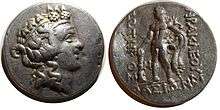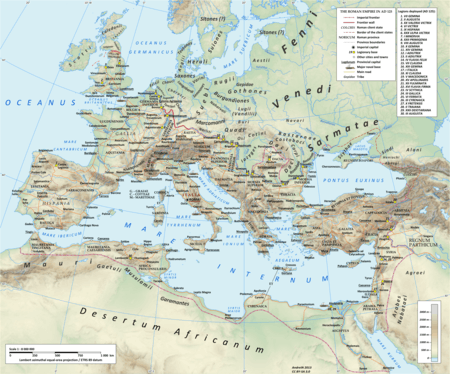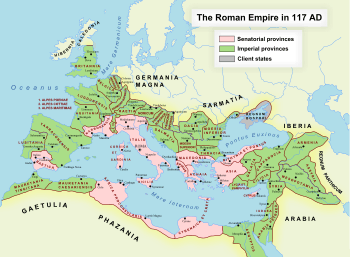Macedonia (Roman province)
The Roman province of Macedonia (Latin: Provincia Macedoniae, Greek: Ἐπαρχία Μακεδονίας) [2][3] was officially established in 146 BC, after the Roman general Quintus Caecilius Metellus defeated Andriscus of Macedon, the last self-styled King of the ancient kingdom of Macedonia in 148 BC, and after the four client republics (the "tetrarchy") established by Rome in the region were dissolved. The province incorporated the former kingdom of Macedonia with the addition of Epirus, Thessaly, and parts of Illyria, Paeonia and Thrace. This created a much larger administrative area, to which the name of 'Macedonia' was still applied.
| Province of Macedonia Provincia Macedoniae ἐπαρχία Μακεδονίας | |||||||
|---|---|---|---|---|---|---|---|
| Province of the Roman Empire | |||||||
| 146 BC–7th century | |||||||
.svg.png) The province of Macedonia within the Roman Empire, circa 125 | |||||||
| Capital | Thessalonica in Late Antiquity: Thessalonica (Macedonia Prima) and Stobi (Macedonia Salutaris)[1] | ||||||
| Historical era | Antiquity | ||||||
• Established after the Fourth Macedonian War | 146 BC | ||||||
• Balkan interior raided by Slavs | 7th century | ||||||
| |||||||
| Today part of | |||||||
Description
Organization
After the reforms of Diocletian in the late 3rd century, Epirus Vetus was split off, and sometime in the 4th century, the province of Macedonia itself was divided into Macedonia Prima in the south and Macedonia Secunda or Salutaris in the north. These provinces were all subordinate to the Diocese of Macedonia, one of three dioceses comprising the praetorian prefecture of Illyricum. When the Prefecture was divided between the Western and Eastern Empires in 379, the Macedonian provinces were included in Eastern Illyricum. With the permanent division of the Empire in 395, Macedonia passed to the East, which would evolve into the Byzantine Empire.
The Dardanians, to the north of the Paeonians, were not included in the Roman province of Macedonia, and they initially had supported the Romans in their conquest of Macedonia, but later felt into confrontation with Rome.[4]
Achaea
Achaea or Achaia was initially part of the Roman Province of Macedonia (from 146 to 27 BC). It later became a separate Province by the Augustan Settlement of 27 BC, which established the Roman Empire.
Epirus Vetus
.svg.png)
Epirus, later Epirus Vetus ("Old Epirus"; Ancient Greek: Παλαιᾶ Ἤπειρος), was a province in the Roman Empire that corresponded to the region of Epirus. Between 146 BC and 27 BC, it was part of the province of Macedonia, after which it became part of Achaea, before becoming a separate province under Emperor Trajan.
Epirus Nova
Epirus Nova ("New Epirus", Ancient Greek: Νέα Ἤπειρος) or Illyria Graeca[5][6][7] or Illyris proper was a province of the Roman Empire established by Diocletian during his restructuring of provincial boundaries. Until then, the province belonged to the province of Macedonia.[8][9] Dyrrachium (or Epidamnus) was established as the capital of Epirus Nova.[10] The region of Epirus Nova corresponded[11] to a portion of Illyria that was then "partly Hellenic and partly Hellenized".[12]
Macedonia Prima

Macedonia Prima ("First Macedonia") was a province encompassing most of the kingdom of Macedonia, coinciding with most of the modern Greek region of Macedonia, and had Thessalonica as its capital.
Macedonia Secunda or Salutaris
Macedonia Salutaris ("Wholesome Macedonia"), also known as Macedonia Secunda ("Second Macedonia") was a province partially encompassing both Pelagonia and Dardania and containing the whole of Paeonia. The province mostly coincides with the present-day North Macedonia. The town of Stobi located to the junction of the Crna Reka and Vardar (called in Greek Axios) rivers, which was the former capital of Paeonia, arose later in the capital city of Macedonia Salutaris.
Thessalia
This province was encompassing the area of ancient Thessaly, which was right in the south of ancient Macedonia. Also herein are being mentioned the subdivisions of Thessalia Prima and Thessalia Secunda.
Economy

The reign of Augustus began a long period of peace, prosperity and wealth for Macedonia, although its importance in the economic standing of the Roman world diminished when compared to its neighbor, Asia Minor.
The economy was greatly stimulated by the construction of the Via Egnatia, the installation of Roman merchants in the cities, and the founding of Roman colonies. The Imperial government brought, along with its roads and administrative system, an economic boom, which benefited both the Roman ruling class and the lower classes. With vast arable and rich pastures, the great ruling families amassed huge fortunes in the society based on slave labor.

The improvement of the living conditions of the productive classes brought about an increase in the number artisans and craftspeople to the region. Stonemasons, miners, blacksmiths, etc. were employed in every kind of commercial activity and craft. Greek people were also widely employed as tutors, educators and doctors throughout the Roman world.
The export economy was based essentially on agriculture and livestock, while iron, copper, and gold along with such products as timber, resin, pitch, hemp, flax and fish were also exported. Another source of wealth was the kingdom's ports, such as Dion, Pella, Thessalonica, Cassandreia.[13]
List of Roman governors
Republican
- Quintus Caecilius Metellus Macedonicus (147 BC);
- Gnaeus Egnatius (146/145 BC);
- Lucius Julius Caesar (93/92 BC);
- Gnaeus Cornelius Dolabella (80—78 BC);
- Appius Claudius Pulcher (78—76 BC);
- Gaius Scribonius Curio Burbulieus (75/74 BC);
- Lucius Manlius Torquatus (64/63 BC);
- Gaius Antonius Hybrida (62/61 BC);
- Gaius Octavius (60/59 BC);
- Lucius Appuleius (c. 58 BC);
- Lucius Calpurnius Piso Caesoninus (57—55 BC);
- Quintus Ancharius (c. 54 BC);
- Titus Antistius (50 BC);
- Marcus Favonius propraetor (?) (48 BC)
Imperial
- Lucius Tarius Rufus (18-16 BC)
- Publius Vinicius (AD 2/3)
- Publius Memmius Regulus (with Achaea, between AD 31 and 37)
- Marcus Helvius Geminus (before 54)[14]
- M. Julius Romulus (between 54 and 68)[15]
- Marcus Vettius Bolanus (before 66)[15]
- Lucius Antonius Saturninus (76/77)[16]
- P. Tullius Varro (between 70 and 79)
- Lucius Baebius Honoratus (before 83)
- Gaius Salvius Liberalis (84/85)
- L. Cocceius Justus (c. 100)
- Q. Annius Maximus (113/114)
- M. Arruntius Claudianus (between 96 and 118)
- Octavius Antoninus (119/120)
- Lucius Varius Ambibulus (124/125)
- Junius Rufinus (between 118 and 138)
- Q. Gellius Sentius Augurinus (between 118 and 139)
- [Iul]ius [Fr]ugi (c. 138)
- Sextus Pedius Hirrutus Lucilius Pollio (c. 148)[17]
- P. Antius Orestes (164/165)
- Publius Julius Geminius Marcianus (c. 166)
- [... A]qu[i]linus (between 139 and 180)
- Cornelius Rufus (between 161 and 180)
- Marcus Antius Crescens Calpurnianus (c. 200)
- Dulcitius (c. 300)
- Calliopius of Antioch (362)
Notable individuals
Citizens
- Damon of Thessalonica 2nd century BC
Saints and clerics
- Agape, Chionia, and Irene(died 304)
- Agathopous, deacon
- Aristarchus of Thessalonica, 1st century
- Demophilus of Constantinople (died 386), Bishop, born in Thessalonica
- Epaphroditus, first bishop of Philippi
- Gaius, first Bishop of Thessalonica
- Lydia of Thyatira, 1st century
- Matrona of Thessalonica
- Onesimus, first bishop of Beroea
- Saint Demetrius, patron saint of the city of Salonika, martyred in 306
- Theodulus, Lector
Writers
- Craterus of Amphipolis (c. 100-30 BC) Rhapsode winner in Amphiarian games[18]
- Phaedrus of Pieria (c. 15 BC – c. AD 50), fabulist
- Antipater of Thessalonica (late 1st century BC), epigrammatic poet and governor of the city
- Philippus of Thessalonica (late 1st century AD), epigrammatic poet and compiler of the Greek Anthology
- Archias, epigrammatist
- Antiphanes (late 1st century), epigrammatist
- Parmenio (late 1st century), epigrammatist
- Criton of Pieria, historian
- Polyaenus, (2nd century), military writer
- Stobaeus (5th century), anthologist of Greek authors
- Macedonius of Thessalonica (6th century), epigrammatist of Greek Anthology
Physicians
- Athryilatus of Thasos
- Alexander of Pella
- Damian of Thessalonica
- Anthemius of Edessa
- Paul of Philippi
- Theodorus of Kato Kleines, Florina
- C. Iulius Nicetas of Lyke (Lyki) in Pella
- Aurelius Isidorus of Thessalonica
- Sextus Iulius Chariton of Amphipolis
- Servia of Thessalonica
- Pubicius [sic?] Lalus and Publicius Hermias of Beroea
- Aelius Nicolaus of Edessa
- Aptus of Dion[19]
See also
- Diocese of Macedonia
- Macedon
- Macedonia (region)
References
- A Companion to Ancient Macedonia, By Joseph Roisman and Ian Worthington, page 549
- Archived 2017-04-24 at the Wayback Machine D. C. Samsaris, Historical Geography of the Roman province of Macedonia (The Department of Western Macedonia today) (in Greek), Thessaloniki 1989 (Society for Macedonian Studies).ISBN 960-7265-01-7.
- Archived 2017-04-24 at the Wayback Machine D. C. Samsaris, Historical Geography of Eastern Macedonia during the Antiquity (in Greek), Thessaloniki 1976 (Society for Macedonian Studies).ISBN 960-7265-16-5.
- "With the arrival of the Romans in the territory of Illyricum in 200 B.C., the Dardani took the side of the (Roman) Republic and significantly strengthened their positions against Macedonia by occupying the area of Paeonia. However, after the defeat of Perseus in 168 B.C., and especially from 148 B.C., when Macedonia ceased to be independent and fell under Roman rule, the Dardani, left without constant raids against their southern neighbor, now entered into confrontation with Rome. The Roman occupation and annexation of Dardania was not carried out in a short time – it was a process unfolding through several war conflicts and, I would say, with certain reluctance." For more see: Vladimir P. (2006). "Pre-roman and Roman Dardania historical and geographical considerations". Balcanica (37): 7–23.
- The Loeb Editor's Notes, 28 Nova Epirus or Illyris Graeca
- A new classical dictionary of Greek and Roman biography, mythology, and geography: partly based upon the Dictionary of Greek and Roman biography and mythology by Sir William Smith,1851, page 392
- Catholic Encyclopedia - Durazzo
- Handbook of Ancient Geography and History by Ptz Wilhelm, ISBN 1-113-19974-1, The (734) southern portion, or Illyria Graeca, belonged to the province of Macedonia.
- Atlas of Classical History by R. Talbert, 1989, page 175: "... divided the diocese of Moesia into two, styled Thracia and Macedonia, the latter consisting of the provinces from Epirus Nova and Macedonia southward. But there is evidence that Constantine considered ..."
- Hendry, p. 299. The geography is entirely correct for Servius' time, since Diocletian's rearrangement of provincial boundaries included the creation of the province of Epirus Nova out of southern Illyricum with Dyrrachium (=Epidamnus) as its capital.
- Wilkes, J. J. The Illyrians, 1992,ISBN 0-631-19807-5, Page 210
- Athanassakis, A.N. (1977), "N.G.L. Hammond, Migrations and Invasions in Greece and Adjacent Areas (review)", American Journal of Philology, 99: 263–6, JSTOR 293653CS1 maint: ref=harv (link)
- Macedonia - Province of the Roman Empire
- CIL III, 6074 = ILS 975
- Werner Eck, "Über die prätorischen Prokonsulate in der Kaiserzeit. Eine quellenkritische Überlegung", Zephyrus 23/24 (1972/73), pp. 240f
- Unless otherwise stated, the names of the proconsular governors from 69 to 139 are taken from Werner Eck, "Jahres- und Provinzialfasten der senatorischen Statthalter von 69/70 bis 138/139", Chiron, 12 (1982), pp. 281–362; 13 (1983), pp. 147–237
- Unless otherwise stated, the names of the proconsular governors from 139 to 180 are taken from Géza Alföldy, Konsulat und Senatorenstand unter der Antoninen (Bonn: Rudolf Habelt Verlag, 1977), p. 265
- Amphiareion — c. 80-50 BC Epigraphical Database
- www.phl.uoc.gr/eulimene/eulimene03.pdf
